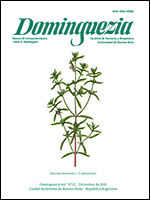Yield, drying, storage and quality of calyxes of Hibiscus sabdariffa L. from Misiones (Argentina)
Keywords:
Hibiscus sabdariffa L., storage, drying, yield, anthocyanin, total acidity.Abstract
Hibiscus sabdariffa L. (Malvaceae) is cultivated in the northeast region of Argentina. Its red and fleshy calyxes are used for food purposes; in a fresh or dry state. Its medicinal use is not very widespread in the region. The objective of the work is to analyze the process of obtaining and storing dry calyxes of H. sabdariffa grown in the province of Misiones and their quality, as well as evaluating local commercial samples by comparing them with the pharmaceutical quality requirements. Organic acids, color intensity, and loss on drying were analyzed according to the Roselle (Hibiscus sabdariffae flos) monograph of the European Pharmacopoeia, and the anthocyanin content by the differential pH method on freshly harvested samples, subjected to different drying temperatures and storage times, as well as on commercial models. The yield of obtaining dry calyxes was 4,5 %. They fulfilled the test for acid titration and color intensity. The anthocyanin content was significantly affected by the drying temperature, although the initial values were high and exceeded 450 mg/100 g (dry drug). After 12 months of storage, the color changed from deep red to a brownish-brown color, the aroma decreases, and the crunchy consistency disappears. Moreover, there is an increase of acid compounds and loss on drying (over 11,0 %), with a reduction in the anthocyanin content and light absorption intensity at 520 nm. The commercial samples verify the same results. The conventional packaging and storage of Hibiscus sabdariffa L. calyxes would not ensure their pharmaceutical quality within a few months of their processing, so the general recommendations for using dried herbal drugs for 24 months would not be applicable.



